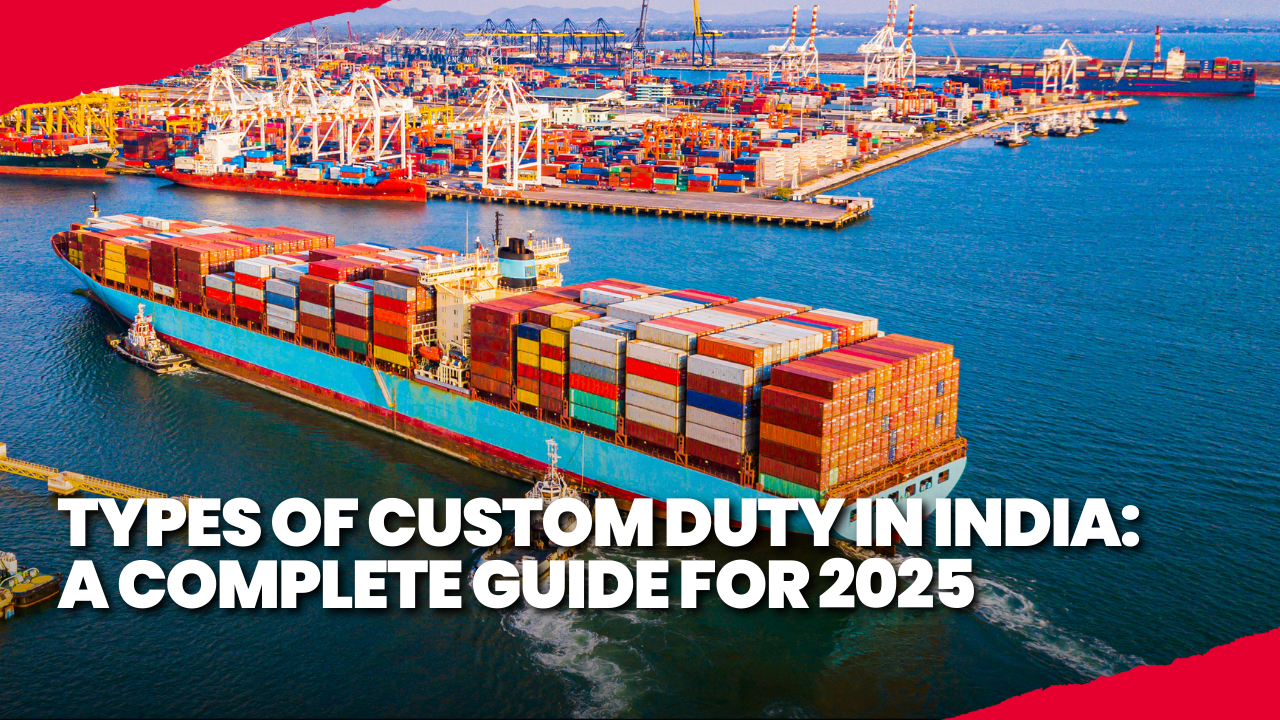
Every time a product enters or leaves India’s borders, it goes through custom, and taxes are applied. These taxes, known as custom duties, are an important part of trade regulations and directly affect the final cost of goods for businesses and consumers.
The government uses different Types of custom duty in India to control imports and exports, protect local industries, and collect revenue. In the financial year 2024–25, custom collections are projected to contribute about ₹2.45 lakh crore to the national budget. Different products attract different types of duties, and understanding these charges is crucial whether you’re a trader, a manufacturer, or someone ordering goods from abroad.
This article explains the main types of custom duty, how they are calculated, and why staying updated matters if you want to avoid extra costs or penalties.
What Is Custom Duty?
Custom duty is a form of indirect tax charged on goods when they move across international borders. It serves multiple purposes, from protecting domestic manufacturers to regulating the inflow of foreign products.
Businesses, especially those that deal with other countries, need to know how custom tax works in India in order to run smoothly and avoid unexpected financial problems.
What are the types of Custom Duty?
There are different kinds of custom duties that India charges. Which are based on the goods, the trade deals, and the country’s own rules.
Here are the main types of custom duty you need to know about.
1. Basic Custom Duty (BCD)
Imported things are subject to this normal duty. The custom Tariff Act of 1975 lists the rates, which are different for each type of goods. It is common to use a proportion of the value of the goods to figure out BCD.
For example, the BCD rate for imported cell phones might be around 20%. While the rate for raw materials like industrial chemicals might be lower.
2. Countervailing Duty (CVD)
The purpose of CVD is to smooth out the excise fees that Indian producers have to pay. An equal CVD makes sure that imports don’t get an unfair lead if a similar product made in India is taxed.
3. Special Additional Duty (SAD)
At one time, SAD was used at 4% to make sure that all Indian states had the same sales tax rate. Since GST was put in place, SAD isn’t charged as often, but it is still charged in some situations, like when goods are imported into a SEZ.
4. Anti-Dumping Duty
We charge an anti-dumping duty to help Indian producers when foreign companies sell goods in India at too low prices. The tax is figured out by taking the difference between what the item is worth in the country that is transporting it and how much it is sold for abroad.
In 2023, India imposed anti-dumping taxes on steel goods that came from China and Vietnam.
5. Protective Duty
Governments and the Tariff Commission both support and place protective duties on foreign goods that could hurt local businesses by being affordable or made in large quantities abroad.
6. Safeguard Duty
You have to pay this temporary tax when sudden increases in imports affect the health of the local industry, even if there aren’t any unfair price practices like dumping. It gives Indian companies time to change while keeping up with the competition.
7. Education Cess and Social Welfare Surcharge
There are extra fees on top of custom duties that pay for aid and education programs. These fees are not a normal tax. For most things right now, there is an extra 10% Social Welfare Surcharge on top of the BCD.
Also Read This: How to Import Cars From Dubai to India
Recent Updates on Custom Duty in India (2025)
Budget 2024–25 changed the system of custom duties, which affected more than 300 goods.
To help India reach its “Atmanirbhar Bharat” goals, lower custom charges have been put on important parts like lithium-ion batteries, parts for electric vehicles, and semiconductors for computers.
Because of the current account gap, import taxes on gold and other expensive goods will stay high.
To make better plans for buying and pricing, you need to stay up to date on these changes.
How to Calculate Custom Duty
Use the following formula to figure out the total custom duty.
Custom Duty = Basic custom Duty + Social Welfare Surcharge + IGST + Other applicable charges (CVD, Anti-Dumping Duty, etc.)
CIF Value (Cost + Insurance + Freight) is the base.
When you pay duties, you first pay the BCD, then the fee, and finally the GST.
If you bring in things worth ₹1,000,000 (CIF) and the BCD is 10%, the total cost will go up by about ₹10,000, which includes the fee and GST.
Why it’s Important to Know the Different Types of custom Duty Cost Planning:
- Businesses can plan their total landed costs more correctly and avoid financial shocks if they know the different types of custom tax.
- If you wrongly report or undervalue imports, you could face penalties, have your things taken away, and damage to your image.
- A business can price its goods more competitively and beat the competition if it knows more about custom duty in India.
Wrapping It Up
Any business, importer, producer, or even individual buyer needs to know about the different types of custom tax. It’s no longer just a job for custom agents. Custom tax in India is changing all the time to keep up with international trade. Staying up to date will help you make better plans, stay in compliance, and make more money from your business.
If you know about these taxes, you’ll be in charge when you bring in goods, whether they are finished or raw materials. You won’t have to deal with expensive shocks at the custom gate.
FAQs
For goods and services that stay in India, GST does not apply. However, goods that cross foreign lines still have to pay custom duty. Imports are subject to basic custom taxes and IGST.
It is important to keep trade fair by charging high custom duties on luxury goods like expensive cars, gold, silver, and some gadgets.
Also Checkout Our YouTube Channel: @limeinstituteofexportimport






